
by Sandra Gulland | Apr 14, 2019 | Adventures of a Writing Life, Promotion, The Shadow Queen, The Writing Process, Work in Process (WIP) |
Where have I been?
When we arrived in San Miguel de Allende (Mexico) over five months ago, I went on a blogging spree. I was inspired, in part, by the refreshing wonder of fast internet. A month later, I stopped writing blog posts, getting down to the business of writing the keynote speech I was to give at the San Miguel Writers’ Conference mid-February.
As well, The Shadow Queen had been chosen as the Conference’s “Big Read” and an event was organized presenting it to book clubs. The event ended up including a video interview of me on writing The Shadow Queen, two lively short lectures by experts on the historical period, and a dramatic performance from the novel—plus champagne and authentic French beignets.
Being an all-or-nothing sort of person, I got very involved in scripting the film, which you can see here. Denis Lanson, the film-maker, did a wonderful job.
The short dramatic performance was my suggestion (in lieu of a reading). I discovered that it was quite a challenge to write. Wonderful actor friends Marilyn Bullivant and Rick Davey performed it. We went through several rehearsals (necessitating rewrites) together with Karen Kinney, head of the committee (a creative committee from heaven, IMO).
In short, a good part of December, January and early February was entirely taken up with writing the keynote, preparing readings for several Conference panels, and scripting the film interview and dramatic presentation of The Shadow Queen. All very exciting!

On stage before my keynote.
The Conference went wonderfully well. I still glow thinking of the reception to my keynote—a standing ovation from an audience of about five hundred—this in addition to the thrill of so many people reading The Shadow Queen. It was a highlight of my life as a writer.
In the weeks that followed, I struggled to get back to work on the WIP, an increasingly curious little novel about a young falconer in Elizabethan England. I went through all the stages of the writing process, including the requisite, “This is garbage, I should just retire” phase. (“What! You’re on Chapter Four already?” one writer’s husband would say whenever she voiced that thought.)
I made a self-appointed deadline mid-April to deliver an outline and character “bible” to Allison McCabe, the wonderful editor of historical fiction who worked with me on The Game of Hope. I delivered it Saturday morning, then celebrated with a lunch margarita at Casa Blanca, one of our favourite restaurants in San Miguel this year.

The working title of the WIP is now Raptor Wild, which I rather like. The “outline” is a mix of bare-bone scenes (mostly dialogue) and narrative plot points, weighing in at a hefty 14,392 words. The character “bible” is simply a page or two on each of the thirteen main characters, including a gyrfalcon and an elderly English Water Spaniel. A significant number of the characters die or are killed off rather early on in the story—somewhat too grim for a YA, I suspect.

“Beauty,” one of the WIP characters.
Although this was only an outline, I developed all the usual symptoms of being in final draft mode. Invariably, at that stage, I become obsessed. I get little sleep, cancel all activities that are not work-related, and become convinced I have a fatal illness. That’s when I think: Ah, almost there. How wonderful to send files off and experience a miraculous cure!

Now that Raptor Wild has been wrapped up (for now), it’s time to prepare to leave San Miguel—never easy. I love getting back home to Canada, but I hate leaving Mexico, too. We’ve had a wonderful winter here this year.

Next up, the paperback release of The Game of Hope, all gussied up in a beautiful new cover!
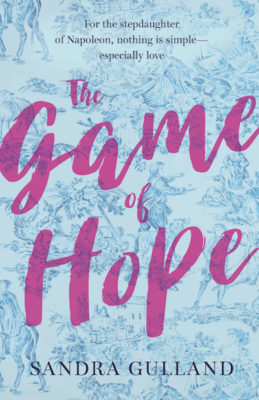
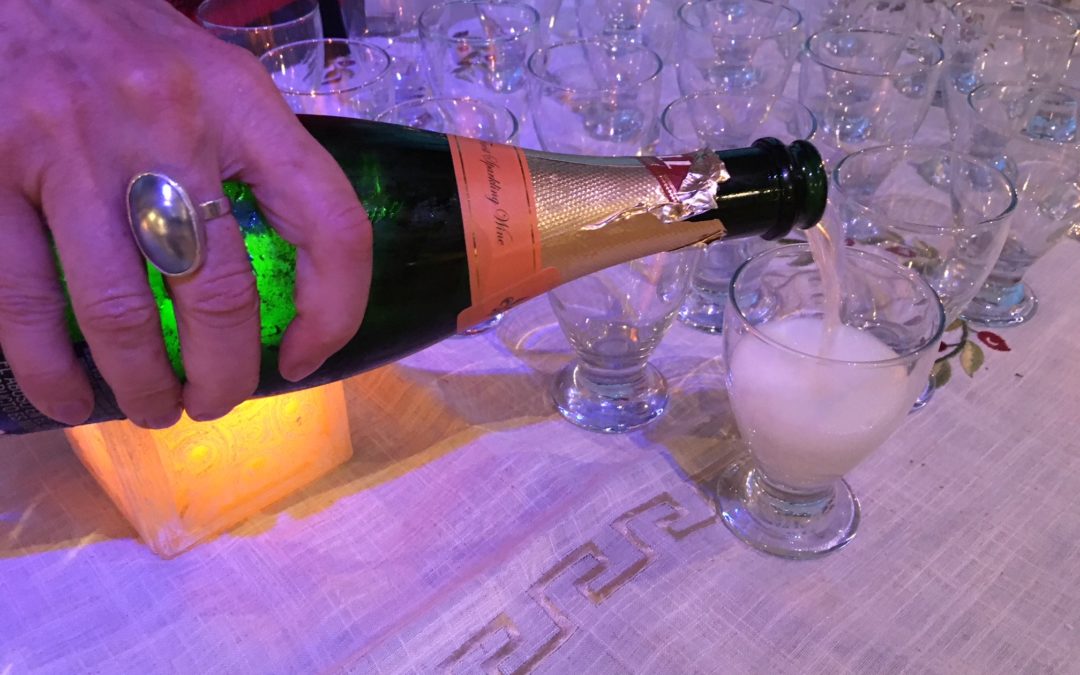
by Sandra Gulland | Jan 19, 2019 | Adventures of a Writing Life, Promotion, The Shadow Queen |
I’ve been quite busy this last month preparing for an event launching The Shadow Queen as San Miguel de Allende’s Big Read. (See my recent blog post about it here.) I wasn’t going to be able to be at the event myself,* but I worked closely with Karen Kinney, head of the committee organizing this event. They did a fantastic job! The event was held last Monday and judging from a number of emails I’ve received, it was a smashing success.
Part of the presentation was this video by film-maker Dennis Lanson, an interview of me on researching and writing The Shadow Queen.
This was followed by two short lectures on 17th century France and a dramatic reading from the novel by wonderful actors Marilyn Bullivant and Rick Davey. Live, period-authentic music, champagne (which was accidentally invented at that time) and beignets (a sweet French treat featured throughout the novel), rounded out the evening.
I wish I could have been there, but we had made holiday plans a year before on the Pacific coast of Mexico, which is where we are now. :-)

Last night’s sunset: spectacular!
My next event will be giving a keynote at the San Miguel Writers’ Conference on February 14, Valentine’s Day. I’ve been reading my talk out loud — honing it, timing it — while walking the beach. It’s a lovely way to rehearse.
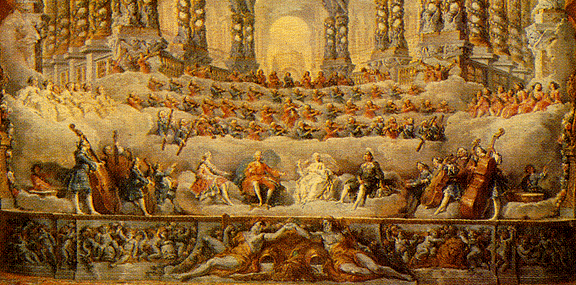
by Sandra Gulland | Dec 17, 2018 | Mistress of the Sun, Recommended Books, Movies, Podcasts, etc., Resources for Book Clubs, Resources for Readers, The Shadow Queen, The Sun Court Duet |
The Baroque era in music generally spans 1600 to 1750. Mistress of the Sun and The Shadow Queen fall in what is called the “High Baroque” period (1650-1700), when French music rose to one of the peaks of its own unique expressive style.
Today, the best-known French Baroque composers are Jean-Baptiste Lully (1632-1687), Marc-Antoine Charpentier (1643-1704) and Jean-Phillippe Rameau (1683-1764).
Jean-Baptiste Lully
Lully, a dancer and violinist born in Italy, became the court composer to Louis XIV in 1661, and a personal friend of the King. For over twenty years, he created the soundtrack underpinning all great occasions during the Sun King’s reign, including church music, operas, ballets, and much, much more.
YouTube has free excerpts of French Baroque music performed by ‘period’ ensembles, or groups that play using instruments and styles similar to those used at the time.
This excerpt of Lully’s brilliant opera Armide (1686), performed by Les Arts Florissants, directed by William Christie, gives an idea of the beautiful sounds of this period. This excellent group regularly plays and records French Baroque music. Also look out for Le Concert d’Astrée, directed by Emmanuelle Haim, and the work of Le Concert des Nations, directed by Jordi Savall, amongst many others.
Marc-Antoine Charpentier
Charpentier’s life was not so charmed. Labouring in Lully’s shadow, but arguably of equal talent, Charpentier never succeeded at getting an all-important court appointment but depended largely on the support of the powerful Jesuits. Even after Lully’s death in 1687, groups of Lully’s fans decried Charpentier’s work, insisting it was ‘too Italian’ to be truly French music. This hindered his success in his own lifetime, but his music is extraordinarily beautiful: you can listen to a live performance of a sonata for eight instruments here, played by the orchestra of Les Folies Françoises. Charpentier’s operas, like Médée, and oratorios, like David et Jonathas, are well worth seeking out on CD, but they’re best of all in live performance!
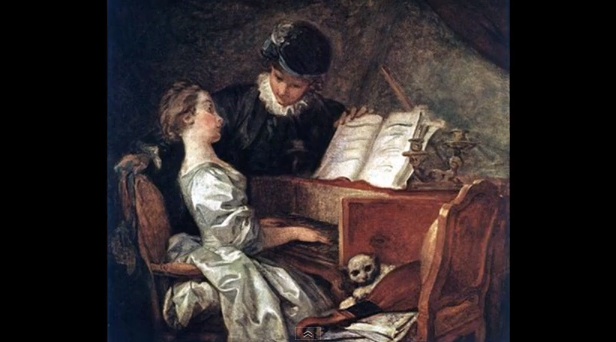
Jean-Phillippe Rameau
Where Lully was France’s greatest composer of the seventeenth century, Rameau was the giant of the eighteenth: he began his career as a celebrated music theorist and teacher and a composer of keyboard pieces, like the Pièces de clavecins (here played by Blandine Rannou).
Rameau only started writing opera at the age of 50, but they astonished the Parisian community, and immediately caused great conflict with the conservative fans of the sounds of Lully. He still met with great success, and collaborated with many fine authors, including Voltaire, to produce brilliant opera. ‘Tristes apprêts, pâles flambeaux’ is just one song from his opera Castor et Pollux; the video contains French and English subtitles, as well as glimpses of the musical manuscript and stills from the 2006 film “Marie Antoinette.”

You might also enjoy …
Although not necessarily a perfect historical or geographical fit, I enjoy the following YouTube links for background listening. (You might notice that they have a somewhat different sound from the examples above. Most of these are played on what we think of as modern instruments, whereas the examples above are played on “period” instruments, and are, therefore, closer to the original sound.)
The Best of Baroque: with renowned harpsichordist Ed Clark, violinist Brunilda Myftaraj and cellist Kathy Schiano.
Baroque Garden for Concentration — No. 7
Airs de Cour — French Court Music from the 17th Century.
From the “High Baroque” period in Venice:
Vivaldi’s Flute Concerto in D Major, RV429, played by the Accademia Montis Regalis.
Vivaldi’s Flute Concerto in G minor, ‘La Notte’, Op.10/2, played by Europa Galante.
‘Winter’ from Vivaldi’s Four Seasons, played by the excellent Il Giardino Armonico.
Educational overviews:
For an educational overview, I recommend Best Baroque Music Composers, French Baroque (a lecture on “High Baroque” style plus recordings) and My favourite Baroque music.
A CD recommendation:

A beautiful CD, should you wish to purchase, is Chorégraphie, Music for Louis XIV’s dancing masters, by Andrew Lawrence-King.
Enjoy!
Most all of the knowledgeable information on this page is from Dr. Katie De La Matter, a scholar and performer of Baroque music. Thank you, Dr. Katie!
Information about the glorious image at the top can be found here.
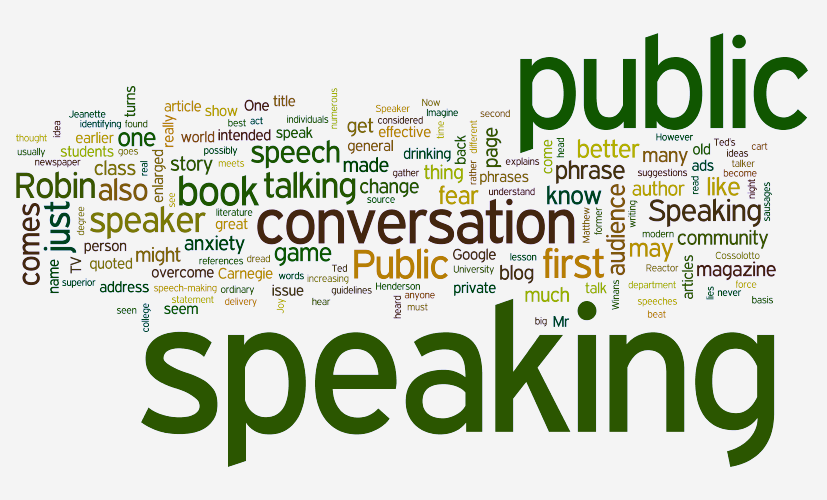
by Sandra Gulland | Dec 3, 2018 | Adventures of a Writing Life, Promotion, The Shadow Queen |
I’ve been combing through old blog posts, preparing for The Big Read in San Miguel de Allende of The Shadow Queen this coming January. For one, I need to have my website in order, especially the posts that relate to that novel. I also need to refresh myself on the process I went through in writing it. It has been a moving exercise.
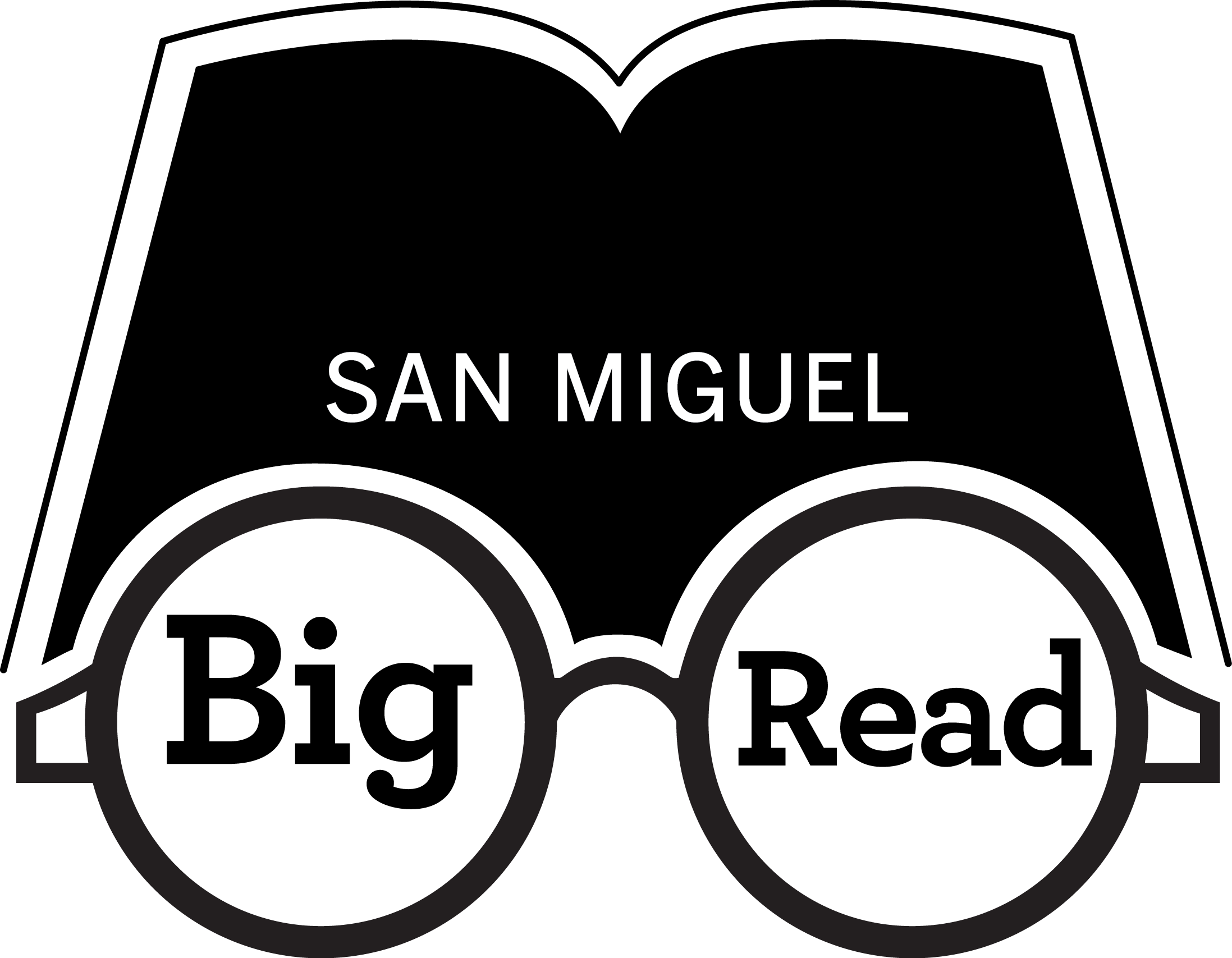
As soon as this is done, I will need to begin crafting my keynote speech. February will be upon me in no time. It seemed appropriate that in combing through my website I happened upon an interview I gave on Jane Friedman’s blog some time ago. In response to Kristen Tsetsi‘s question on public speaking, I outlined my process. I share it here — with some additional stories of things I’ve learned since.
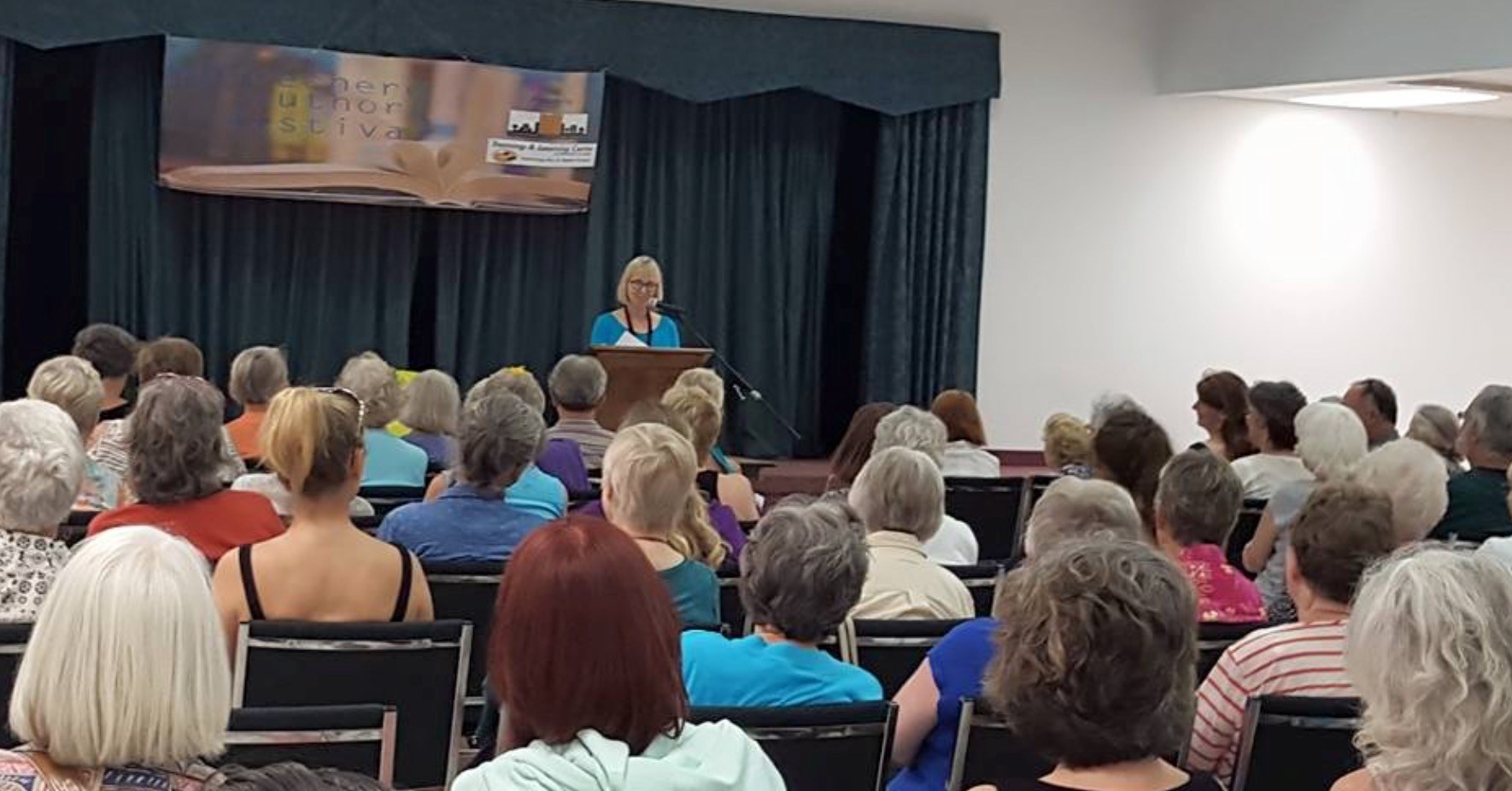
Q: A reading, you’ve said, is more like a talk, an opportunity for the author to engage with the audience. What five pieces of advice would you give authors about to deliver their first reading/talk?
Most writers are introverts and find public speaking daunting. Take heart! Introverts are, as a rule, excellent public speakers, but only because they prepare like crazy.
Here is my process …
Write the talk: every word of it
Put a lot of time into writing a good talk. Write out every word of your presentation. Aim for only about five to ten minutes of reading, and the rest of it talk, leaving time for about fifteen minutes of Q&A at the end. Type the sections of your book you plan to read into your speech.
In general, people love to laugh, and self-deprecating humor goes over well. Remember that you are there to entertain. Readers enjoy personal accounts about the process of creation.
People like to be participants, so ask questions: engage the audience.
Prepare a few funny questions to suggest at the end, should your audience be shy to speak up during the Q&A.
Your entire talk/reading should be about thirty to forty minutes.
Read the talk out loud: every word of it
Read your talk out loud slowly. Edit the passages you are going to read from your book to make them easy for you to read, as well as easy for listeners to understand. Change words you find difficult to pronounce or stumble over. Think of this as theater. A passage read out loud comes across differently from a passage one reads to oneself silently, so adjustments must be made.
Print the talk out in big bold type
Convert your talk to large bold print, and break each paragraph into sentences. Print out your talk and assemble it in a binder. Dog-ear each page so that the pages are easy to turn.

(I wrote about my speaking process in a blog post here, “Finding focus.”)
Rehearse the talk, over and over
A natural, relaxed presentation is achieved with lots of preparation. A few days before your talk, read in front of a mirror, sweeping up from the page with each sentence to meet your own eyes. The day of the talk, do this two or three times. (A caution about going hoarse, however!)
Slow down as you read—don’t race through it.
Try on what you’re planning to wear—is it comfortable? Do you feel good in it? Do you feel like yourself?
Prepare to present the talk … and to expect glitches
Getting comfortable with public speaking comes with practice.
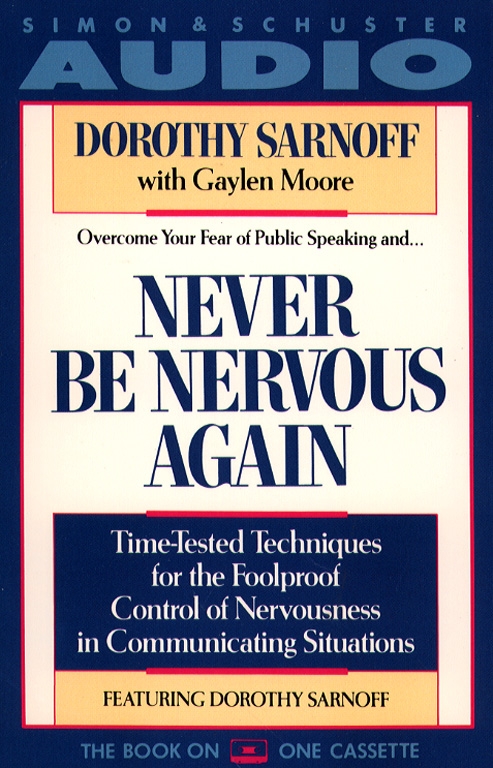
When I was first published, I read and was greatly helped by Never be Nervous Again by Dorothy Sarnoff, who advises speakers to think of the following mantra before a talk: “I’m glad I’m here, I’m glad you’re here, and I know what I know.” Try it! Don’t dread a crowd; embrace it. (I highly recommend this book.)
The most important rule-of-thumb: enjoy yourself — but most of all enjoy the people who have made an effort to come see you …
… including the snoring fan slumped in the front row.
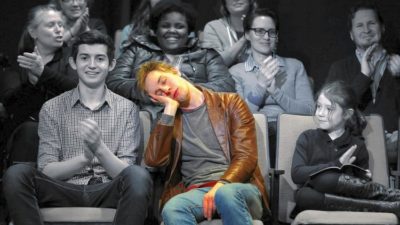
This happens! For amusing stories from actors, read this. (Confession: I’ve once or twice been that snoozing person in the audience myself. When the eyelids start to droop, it can’t be helped!)
I’ve learned that giving out door prizes throughout a talk is not only fun — Who doesn’t love a door prize? — but keeps everyone on their toes.
Find out what the venue is going to be like. Ask for a mike if the group is going to be large. This will allow you to have a more emotional range in your reading. I like to be able to dramatically whisper, for example.
If you plan to give a visual presentation (such as Powerpoint), expect that there will be glitches with the equipment. In my experience, this never fails to happen, and sometimes too with mikes. I’ve learned to bring my own computer, portable projector and cables just in case. If only there was a portable mike one could have on hand, as well.

Plan what you will do in case only one or two people show up. Offer to go to a cafe for a one-on-one chat, for example. Consider this your rite of passage: every author goes through it.
Some of my most memorable talks have been to very small and intimate groups.
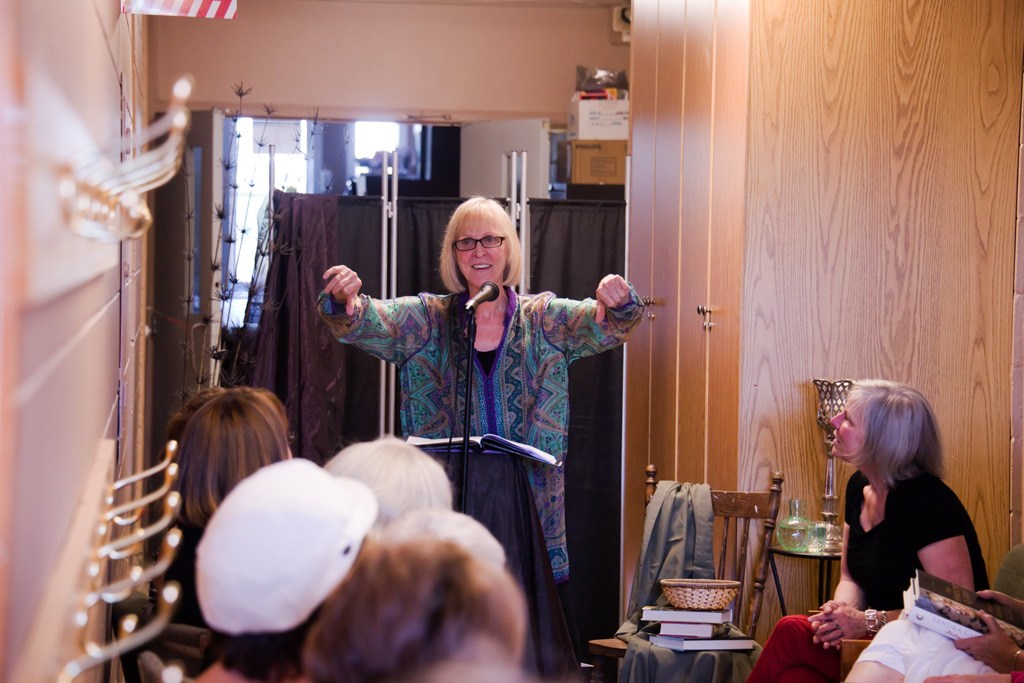
There will be disasters: these will make good stories. Eventually. One of mine was a live TV interview, called an “open-ender” because I was in one city and the interviewer was in another. I could hear his questions through the ear bud in my right ear. And then it fell out and I couldn’t hear a thing. I was filmed scrambling on the floor trying to find it.
I laugh about it now. One wonderful thing about being a writer is that everything is potential material, nothing is wasted.
What public speaking adventures/misadventures have you experienced, either as a speaker or someone in the audience?

by Sandra Gulland | Nov 27, 2018 | Adventures of a Writing Life, Resources for Readers, The Shadow Queen |
This is an exciting winter for me. Not only will I be giving a keynote at the San Miguel Writers Conference in February, but my novel The Shadow Queen has been chosen as “The Big Read.”

What this means is that readers all over San Miguel will be reading The Shadow Queen. (Yes!)
From an article in the Atencion:
“For most of us, who never mastered the intricacies of French history in high school, or never studied it at all, this richly detailed portrait of life in the French court under the rule of Louis XIV will thrust us into an absorbing world, described by an extraordinarily talented writer. It is such an outstanding example of historical fiction that it may open up other alluring worlds to readers who have never ventured into the genre before.
“Every year, the Writers’ Conference hosts the Big Read, inviting everyone in town to read the same book by one of the Conference keynote speakers and then to join one of many Big Read discussion groups around town. We provide discussion questions, present a program to provide background information on the book and the author, and invite all discussion group participants to meet the author in person at a private reception.”
On January 14 there will be an event held to present the novel to book clubs. I’m not able to be there (we will be on the Pacific Coast at that time), but I’m working with the organizing committee to help put together an entertaining presentation.
The first thing I suggested was that they serve beignets, a French pastry featured throughout the novel. That turned out to be fairly easy to arrange since San Miguel is blessed with an excellent French pastry chef.
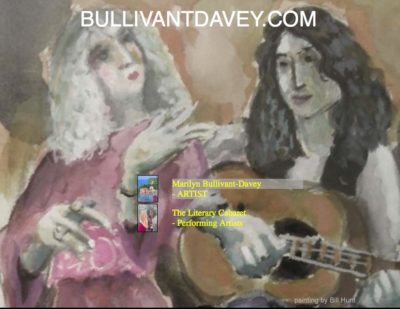
The second thing I suggested was that we recruit my actor friends Rick Davy and Marilyn Buillivant — of Literary Cabaret fame — to put on a short, dramatized reading from the novel. They are keen, and it’s going to be wonderful, but I have since discovered that scripting scenes is not easy!
The committee has also arranged for a filmmaker, Dennis Lanson, to make a short film to show at the event. It will likely partially be an interview of me about the novel — my process and how The Shadow Queen came to be, etc. — and partially images of 17th century theatre and some of the characters in the novel, along with my voice-over commentary. This has entailed a search for images that are of good-enough quality to be projected onto a large screen. Again: not easy!
In going though old blog posts and selecting images, I’ve begun to fall under the spell of that era again. For example, OTT Baroque theatre:

How is it possible not to swoon?
I love, too, this image of Madame de Montespan, the woman we all love to hate:

In order to do all this coherently, I’ve been rereading The Shadow Queen. It has been years since I was in that world, and I have to confess that I’m finding it delightful.
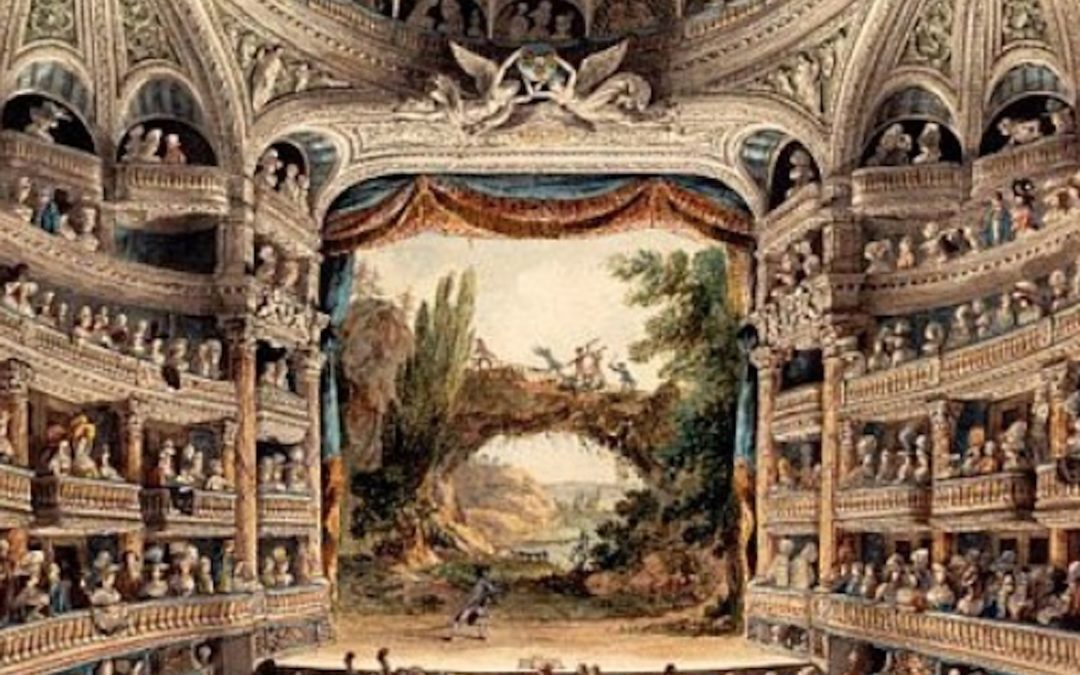
by Sandra Gulland | Nov 18, 2018 | Baroque Explorations, On Research, The Game of Hope, The Shadow Queen |
In preparing for a video presentation of The Shadow Queen to book clubs here in San Miguel de Allende, I’ve been revisiting the world of that novel — especially the magical world of 17th century theatre in Paris. Rereading this blog post, written long ago, I was captured once again by the story of Molière and his much younger wife Armande. Theirs was a story I was planning to write before I got spirited away into the world of The Game of Hope.
And so here, to share, is my post from 2009, spruced up with wonderful visuals. (Thank you, Internet!)
I’m doing a great deal of research right now into the theater world of 17th century France. My focus is on Claude de Vin des Oeillets, the daughter of actors, but along the way I’ve been encountering many wonderful characters. So many stories!
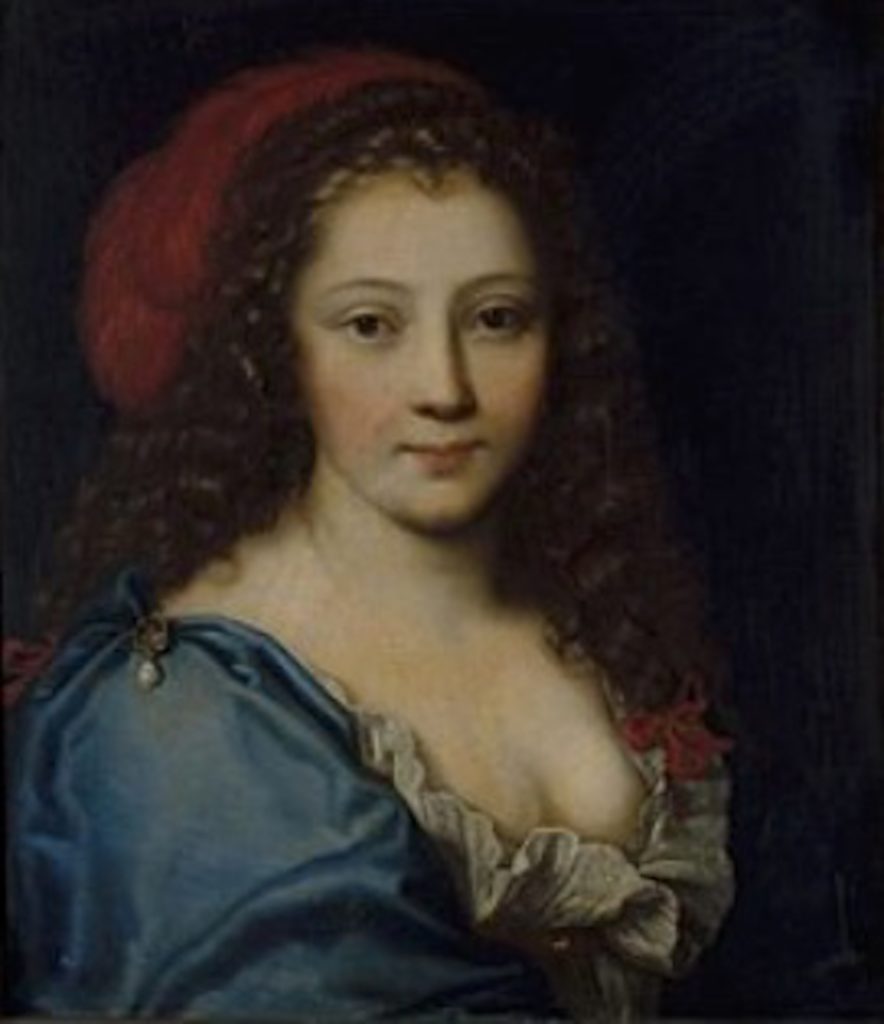
Molière’s wife Armande, 23 years his junior
One, in particular, is that of the actress Armande Béjart, Molière‘s wife. He was 40 when they married, she only 17. She had known him all her life, and must have regarded him as something of a father and teacher. Indeed, he had taken charge of her education as a child.
They were a miserable couple. It is said that Armande was heartless and vain. She was considered a frivolous, giddy flirt, and was quite likely unfaithful (possibly to Lauzun, and possibly to the comte de Guiche); certainly Molière was consumed by jealousy. After the birth of a son, and then a daughter, they lived apart, yet they continued to work together closely on the stage. Molière could simply not stop doting on her . . . and neither could the public. She was a brilliant actress, and Molière was inspired to write many roles specifically for her.
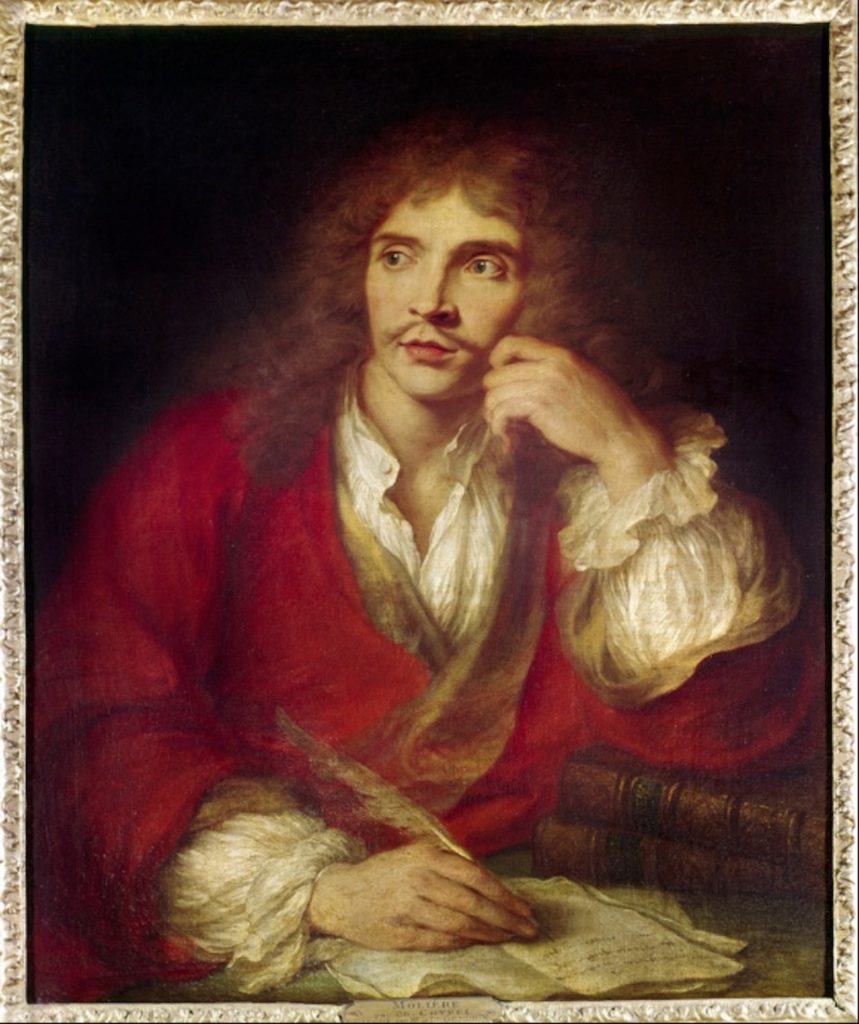
Molière
A mutual friend eventually persuaded Armande to reconcile with her increasingly consumptive and love-sick husband. She did, putting him on a strict meat diet, yet he continued to decline. On the day of the 4th performance of “The Imaginary Invalid,” in which he starred, Armande begged him not to play. He refused, knowing how many depended on the performance for their livelihood.
At the end of play, Molière (ironically playing the part of a hypochondriac) had a convulsion, which he tried to disguise with a harsh laugh. The curtain was hastily lowered and he was carried to his house. Always a comedian, he said on his deathbed: “I have set a detestable example. From now on, no playwright will be content until he has killed an actor.”
After her husband’s death, Armande proved to be anything but giddy and frivolous, fighting passionately for her husband’s right to be respectfully buried by the church (a fight she sadly lost), and then running Molière’s theatrical company with astonishing confidence and aplomb, making a number of difficult decisions that proved to be very successful. He would have been pleased.
I love her saucy attitude, but most of all I love how talented she was, and how capable she proved to be as a widow. Someday I hope to write about her.
[Note: This post was originally published on Hoydens and Firebrands, a website of women who write about the 17th century.]






























